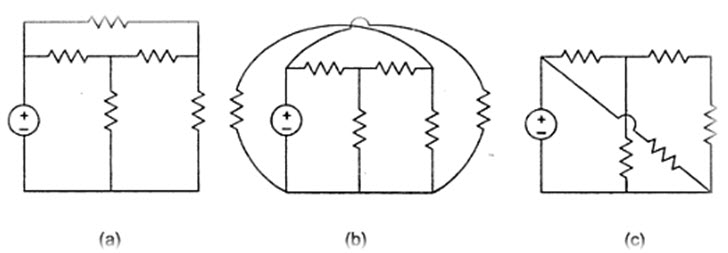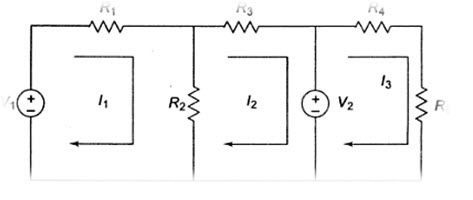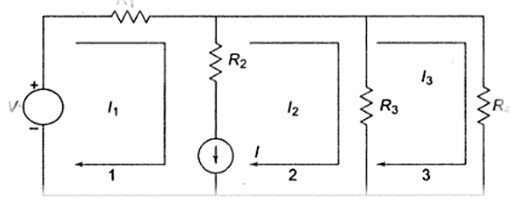Site pages
Current course
Participants
General
Module 1. Average and effective value of sinusoida...
Module 2. Independent and dependent sources, loop ...
Module 3. Node voltage and node equations (Nodal v...
Module 4. Network theorems Thevenin’ s, Norton’ s,...
Module 5. Reciprocity and Maximum power transfer
Module 6. Star- Delta conversion solution of DC ci...
Module 7. Sinusoidal steady state response of circ...
Module 8. Instantaneous and average power, power f...
Module 9. Concept and analysis of balanced polypha...
Module 10. Laplace transform method of finding ste...
Module 11. Series and parallel resonance
Module 12. Classification of filters
Module 13. Constant-k, m-derived, terminating half...
LESSON 5. Loop current and loop equations (Mesh current method)
5.1 Mesh Analysis
Mesh and nodal analysis are two basic important techniques used in finding solutions for a network. The suitability of either mesh or nodal analysis to a particular problem depends mainly on the number of voltage sources or current sources. If a network has a large number of voltage sources, it is useful to use mesh analysis; as this analysis requires that all the sources in a circuit be voltage sources. Therefore, if there are any current sources in a circuit they are to be converted into equivalent voltage sources, if, on the other hand, the network has more current sources nodal analysis is more useful.
Mesh analysis is applicable only for planar networks. For non-planner circuits mesh analysis is not applicable. A circuit is said to be planar, if it can be drawn on a plane surface without crossovers. A non-planar circuit cannot be drawn on a plane surface without a crossover.
Figure 5.1 (a) is a planar circuit. Figure 5.1 (b) is a non-planar circuit and Fig. 5.1 (c) is a planar circuit which looks like a non-planar circuit. It has already been discussed that a loop is a closed path. A mesh is defined as a loop which does not contain any other loops within it. To apply mesh analysis, our first step is to check whether the circuit is planar or not and the second is to select mesh current. Finally, writing Kirchhoff’s voltage law equations in terms of unknowns and solving them leads to the final solution.

Fig. 5.1
Observation of the Fig.5.2 indicates that there are two loops abefa, and bcdeb in the network. Let us assume loop currents I1 and I2 with directions as indicated in the figure. Considering the loop abefa alone, we observe that current I1 is passing through R1, and (I1 – I2) is passing through R2. By applying Kirchhoff’s voltage law, we can write
VS = I1R1 + R2(I1 – I2)

Fig.5.2
Similarly, if we consider the second mesh bcdeb, the current I2 is passing through R3 and R4, and (I2 - I1) is passing through R2. By applying Kirchhoff’s voltage law around the second mesh, we have
R2(I2 – I1) + R3 I2 + R4 I2 = 0
By rearranging the above equations, the corresponding mesh current equations are
I1(R1 + R2) – I2 R2 = VS
- I1R2 + (R2 + R3 + R4)I2 = 0
By solving the above equations, we can find the currents I1 and I2. If we observe Fig. 5.2, the circuit consists of five branches and four nodes, including the reference node. The number of mesh currents is equal to the number of mesh equations.
And the number of equations = branches – (nodes -1). In Fig. 5.2, the required number of mesh currents would be 5 – (4 – 1) = 2.
5.2 Mesh Equations by Inspection Method
The mesh equations for a general planar network can be written by inspection without going through the detailed steps. Consider a three mesh networks as shown in Fig.5.3.
The loop equations are
I1R1 + R2(I1 – I2) = V1 \[...................................................\left( {5.1} \right)\]

Fig. 5.3
R2(I2 – I1) = I2R3 = - V2 \[...................................................\left( {5.2} \right)\]
R4I3 + R5I3 = V2 \[...................................................\left( {5.3} \right)\]
Reordering the above equations, we have
(R1 + R2)I1 – R2I2 =- V1 \[...................................................\left( {5.4} \right)\]
-R2I1 + R2 + R3) I2 = - V2 \[...................................................\left( {5.5} \right)\]
(R4 + R5)I3 = V2 \[...................................................\left( {5.6} \right)\]
The general mesh equations for three mesh resistive network can be written as
R11I1 ± R12I2 ± R13I3 = Va \[...................................................\left( {5.7} \right)\]
± R21I1 + R22I2 ± R23I3 = Vb \[...................................................\left( {5.8} \right)\]
± R31I1 + R32I2 ± R33I3 = Vc \[...................................................\left( {5.9} \right)\]
By comparing the Eqs. 5.4, 5.5 and 5.6 with Eqs. 5.7, 5.8 and 5.9 respectively, the following observations can be taken into account.
- The self-resistance in each mesh.
- The mutual resistances between all pairs of meshes and
- The algebraic sum of the voltages in each mesh.
The self-resistance of loop 1, R11 = R1 + R2, is the sum of the resistances through which I1 passes. The mutual resistance of loop 1, R12 = - R2, is the sum of the resistances common to loop currents I1 and I2. If the directions of the currents passing through the common resistance are the same, the mutual resistance will have a positive sign; and if the directions of the currents passing through the common resistance are opposite then the mutual resistance will have a negative sign.
Va = V1 is voltage which drives loop one. Here, the positive sign is used if the direction of the current is the same as the direction of the source. If the current direction is opposite to the direction of the source, then the negative sign is used.
Similarly, R22 = (R2 + R3) and R33 = R4 + R5 are the self-resistances of loops two and three, respectively. The mutual resistances R13 = 0, R21 = - R2, R23 = 0, R31 = 0, R32 = 0 are the sums of the resistances common to the mesh currents indicated in their subscripts.
Vb = - V2, Vc = V2 are the sum of the voltages driving their respective loops.
5.3. Supermesh Analysis
Suppose any of the branches in the network has a current source, then it is slightly difficult to apply mesh analysis straight forward because first we should assume an unknown voltage across the current source, writing mesh equations as before, and then relate the source current to the assigned mesh currents. This is generally a difficult approach. One way to overcome this difficulty is by applying the supermesh technique. Here we have to choose the kind of supermesh. A supermesh is constituted by two adjacent loops that have a common current source. As an example, consider the network shown in Fig.5.4.

Fig. 5.4
Here, the current source I is in the common boundary for the two meshes 1 and 2. This current source creates a supermesh, which is nothing but a combination of meshes 1 and 2.
R1I1 + R3(I2 – I3) = V
or R1I1 + R3I2 – R4I3 = V
Considering mesh 3, we have
R3(I3 – I2) + R4I3 = 0
Finally, the current I from current source is equal to the difference between two mesh currents, i.e..
I1 = I2 = I
We have, thus, formed three mesh equations which we can solve for the three unknown currents in the network.